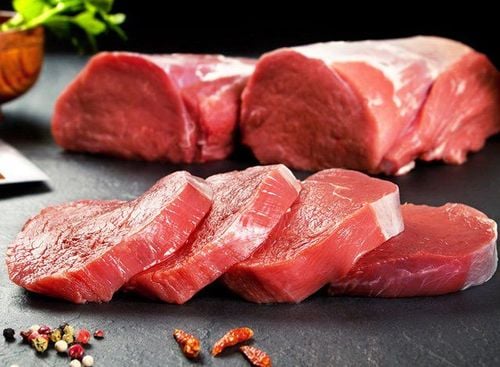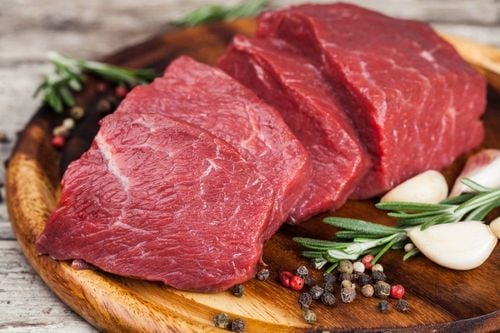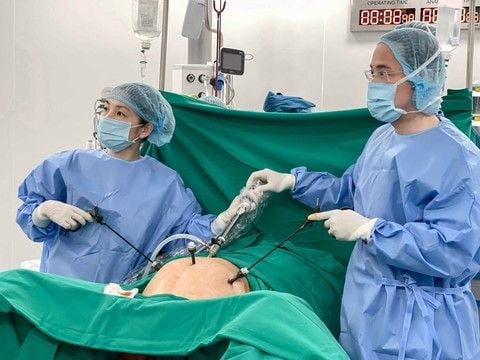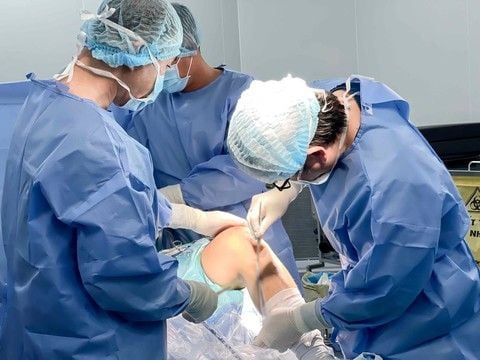Meat is generally divided into two main categories: red meat and white meat, based on several factors, including color of the meat. But why do these differences exist between the two types of meat? The following article will help clarify this question and provide additional information about the benefits of red meat compared to white meat.
1. The difference between red meat and white meat
The primary difference between red and white meat lies in the amount of myoglobin found in the animal's muscles. Myoglobin is a protein in muscle tissue that binds to oxygen, enabling its use as an energy source.
In meat, myoglobin serves as the main pigment responsible for its color, producing a bright red hue when exposed to oxygen. Red meat contains higher levels of myoglobin than white meat, which accounts for the noticeable difference in their colors.
However, various factors can also influence meat color, such as the animal's age, species, gender, diet, and activity levels.
For instance, muscles that are exercised more tend to have higher concentrations of myoglobin, as they require more oxygen for activity. This means meat from such animals will have a darker red color. Additionally, packaging and processing methods may also lead to changes in meat color.
The optimal surface color of raw meat from different types, such as beef, lamb, pork, and veal, should ideally be cherry red, dark cherry red, grayish pink, and pale pink, respectively. For raw poultry, the color can range from bluish-white to yellow.

According to the scientific community and food authorities, such as the United States Department of Agriculture (USDA), pork is classified as red meat. There are two main reasons why pork is categorized as red meat:
• First, pork contains more myoglobin than poultry and fish. Thus, pork is classified as red meat even though it does not have a bright red color and may appear lighter when cooked.
• Second, pigs are considered livestock animals, often grouped with cattle, sheep, and veal. All livestock are categorized as red meat.
2. Is eating red meat healthy?
Question: Does eating red meat increase the risk of cancer and heart disease?
Answer: For heart disease, the answer is relatively clear. Certain types of red meat are high in saturated fats, which raise blood cholesterol levels. High levels of LDL cholesterol increase the risk of heart disease.
As for cancer, the answer is less definitive. Many researchers suggest that red meat increases the risk, particularly for colorectal cancer.
A recent study by the National Institutes of Health (NIH) involving more than half a million older Americans concluded that individuals who consumed large amounts of red and processed meat over 10 years were more likely to die prematurely compared to those who ate less. Those who ate about 4 ounces of red meat daily had a higher likelihood of dying from cancer or cardiovascular disease than those who ate the least, approximately half an ounce per day.
The meat industry argues that there is no link between red or processed meat and cancer, asserting that lean red meat can fit into a heart-healthy diet.
However, numerous studies have identified similar connections. Another study, which tracked over 72,000 women for 18 years, found that those consuming a Western-style diet rich in red and processed meat, desserts, refined grains, and fried potatoes were at a higher risk of heart disease, cancer, and death from various causes.
Marji McCullough, PhD, a nutritional epidemiologist with the American Cancer Society, stated that there is an association between the consumption of red and processed meat and cancer, particularly colorectal cancer.

After reviewing a systematic body of scientific studies, an expert panel from the World Cancer Research Fund and the American Institute for Cancer Research concluded in 2007 that red and processed meat is a cause of certain cancers. Their report provided compelling evidence of a strong link between red and processed meat and colorectal cancer, though the connection remains unclear for lung cancer, esophagus, stomach, pancreas, and endometrium.
Question: If eating red meat increases cancer risk, what are the specific causes?
Answer: The cancer-causing mechanisms of red meat are not fully understood, but researchers are investigating several potential factors, including:
• Saturated fat: Linked to colorectal and breast cancer as well as heart disease.
• Carcinogens: Compounds formed when meat is cooked at high temperatures or overcooked.
• Heme iron: The type of iron found in meat, which can produce compounds that may damage cells, potentially leading to cancer.
Question: Is eating red meat healthy?
Answer: Compared to white meat, red meat contains higher levels of iron, a nutrient that many teenage girls and women of childbearing age often lack. The heme iron found in red meat is easily absorbed by the body. Red meat also provides vitamin B12, which aids in DNA production and keeps nerve cells and red blood cells healthy. Additionally, red meat contains zinc, which supports the immune system, and it is a rich source of protein, which helps build strong bones and muscles.
Nutrition experts highlight that beef is one of the most nutrient-dense foods. A 3-ounce serving of lean beef contains just 180 calories but delivers 10 essential nutrients.

Question: How much red meat should one eat?
Answer: Most nutrition experts recommend focusing on reasonable portion sizes and choosing lean cuts of red meat.
To determine the appropriate amount of red meat for your needs, consider two key factors:
• Are you consuming more calories than you burn?
• Is the amount of red meat you eat exceeding other essential food groups like fruits, vegetables, and whole grains?
You don’t need to eliminate red meat from your diet, but it’s important to select lean cuts and adjust portions to meet your nutritional needs.
The U.S. government guidelines suggest consuming 5 to 6.5 ounces of protein per day from various sources, including lean meat, nuts, and seafood. Therefore, calculate your protein intake from all food sources, including red and white meat, and distribute it evenly across your daily meals.
The American Institute for Cancer Research (AICR), a nonprofit organization focusing on cancer prevention through diet and physical activity, advises limiting cooked red meat to no more than 18 ounces per week. Additionally, the organization recommends avoiding all processed meats, such as sausages, deli meats, ham, and bacon, as they are linked to an increased risk of colorectal cancer.
Question: What are the criteria for a lean cut of red meat?
Answer: Meat can be labeled lean if a 3-ounce serving contains fewer than 10 grams of total fat, 4.5 grams or less of saturated fat, and less than 95 milligrams of cholesterol.
When buying beef, check the USDA classification. "Prime" beef is the highest grade but also contains the most fat. Most supermarkets sell beef that is classified into various product grades.

Question: Is beef from grass-fed cattle better than grain-fed beef?
Answer: Grass-fed beef is leaner than grain-fed beef, resulting in lower total fat and saturated fat content. Grass-fed beef also contains more omega-3 fatty acids. However, the total amount of omega-3 in both types of beef is relatively small. Therefore, foods like fish, vegetable oils, and nuts are better sources of omega-3 than beef.
Question: Does grilling red meat cause cancer?
Answer: Any type of meat, when cooked at high temperatures, can produce compounds that increase the risk of cancer, including red meat, poultry, and fish. These compounds are known as heterocyclic amines (HCAs) and polycyclic aromatic hydrocarbons (PAHs).
Question: How to reduce cancer-causing compounds when grilling?
Answer: You can take several steps to prevent or reduce the formation of cancer-causing compounds when grilling, as follows:
• Choose lean cuts of red meat to reduce the risk of flare-ups or smoke formation, as this can leave carcinogenic substances on the meat.
• Grill over medium heat or use indirect grilling instead of cooking at high temperatures, which can lead to charring and overcooking.
• Avoid overcooking. Well-done meat contains higher levels of carcinogenic compounds, but ensure the meat is cooked to a safe temperature to kill harmful bacteria. For steaks, cook to 145 to 160°F; for burgers, cook to 160°F.
• Marinate the meat. Marinating can reduce the formation of HCAs (heterocyclic amines). Choose marinades low in sugar to avoid burning the surface of the meat.
• Turn the meat frequently. Use tongs or a spoon instead of a fork to avoid releasing juices that could drip onto the fire and cause flare-ups.
• Avoid grilling large quantities of meat at once. Instead of just grilling meat, try skewering meat along with fruits and vegetables for grilling.
• Trim the fat before cooking and remove any burnt pieces of meat before eating.

Both red and white meats provide essential nutrients for the body, but to ensure good health, they should be prepared and consumed appropriately to minimize the risk of illness.
Diet plays a significant role in your health. If you experience any unusual symptoms or suspect cancer, it is important to visit a reputable medical facility for a proper examination and accurate diagnosis. Currently, Vinmec International General Hospital offers high-accuracy cancer screening packages. For more information, you can contact the Vinmec healthcare system nationwide or register for an online consultation.
To arrange an appointment, please call HOTLINE or make your reservation directly HERE. You may also download the MyVinmec app to schedule appointments faster and manage your reservations more conveniently.
Reference source: webmd.com; healthline.com
To arrange an appointment, please call HOTLINE or make your reservation directly HERE. You may also download the MyVinmec app to schedule appointments faster and manage your reservations more conveniently.








